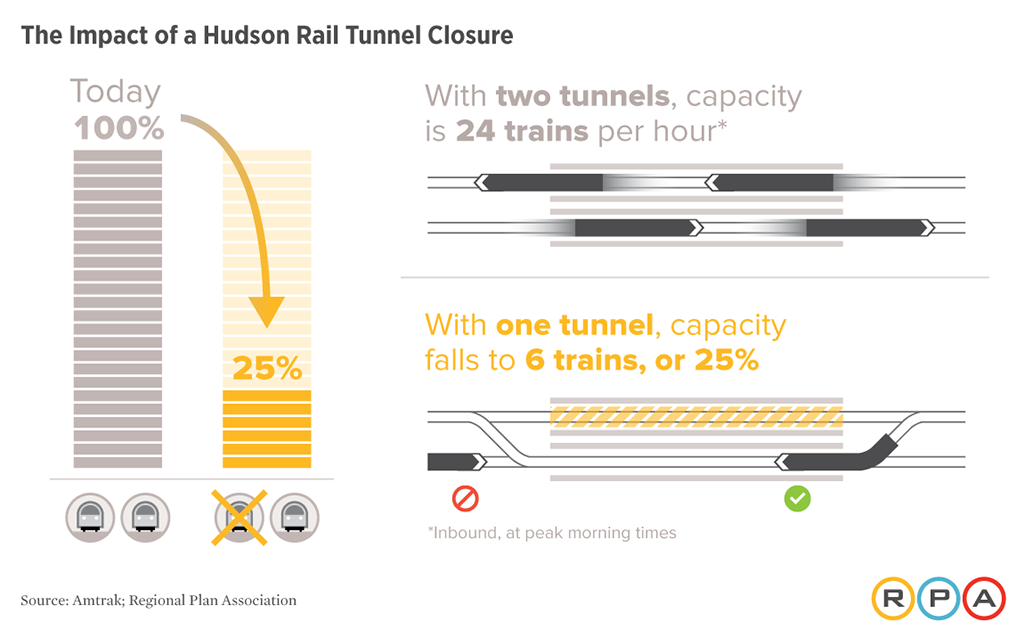If you’re not a regular New Jersey Transit commuter or Amtrak rider you might not have given a lot of thought to Gateway. Here’s a quick primer on what it is, why it matters to you, and to the entire nation.
What is the Gateway Program?
The Gateway Program is a series of repairs, replacements and expansions that will replace outdated infrastructure and create new capacity on a 10-mile segment of the Northeast Corridor (NEC) rail line, between New Jersey and New York.
The first phase of the Gateway Program includes the construction of a new tunnel under the Hudson River, the rehabilitation of the existing tunnel, the completion of a concrete casing on the West Side of Manhattan to preserve right-of-way for the future tunnel to New York’s Penn Station, and the replacement of the Portal Bridge.
Later phases of the Gateway Program would include a second Portal Bridge South to double rail capacity in this heavily used section of the Northeast Corridor, the replacement of the Sawtooth Bridges located in Harrison, New Jersey, and the expansion and modification of Penn Station in New York, Newark Penn Station and Secaucus Junction Station (“Bergen/Secaucus Loop”) in New Jersey.
RPA has also advocated for extending Gateway through to Queens.

Why is critical?
The Gateway program solves a number of different challenges, and opens up a chokepoint on the Northeast Corridor. But most critically Gateway builds redundancy for the North River Tunnel, the “tubes” through which approximately 450 trains and 200,000 passengers cross between New Jersey and New York each day. This century-old tunnel was inundated with seawater during Superstorm Sandy and is in urgent need of repairs.
Even if officials had to close one of the tubes in the tunnel for emergency repairs it would throttle an already congested connection down further, reducing its capacity by 75%. This would shift tens of tens of thousands of more cars onto already congested highways and bridges, and force Amtrak passengers to switch to road or airplane.

Since the vast majority of freight in our area moves by truck, tens of thousands of additional cars on area roads would gridlock the movement of goods up and down the East Coast. This would harm the regional economy, which is responsible for 20% of the nation’s GDP.
The shift of even a fraction of the 21,000 daily Amtrak passengers who rely on this tunnel to air traffic would impact air travel nationwide. A 2012 study showed that nearly ⅓ of all air traffic delays across the country originate from delays at airports in the New York metro area. Thousands of additional passengers flooding our already capacity constrained regional airports would gridlock the nation’s skies.
It took 14 months to repair the Minneapolis Bridge. It stands to reason that undertaking an emergency tunnel rehab may take much longer. In that timeframe employees may choose to leave jobs due to stressful commutes, employers may choose to relocate, causing more economic disruption.
Building Gateway isn’t just about preventing disaster. It’s also about enabling continued access to employment opportunities, especially for those who cannot afford or do not wish to live in the five boroughs. It’s about enabling continued growth for one of the most economically productive regions in the country. TransHudson travel is forecast to keep growing regardless of whether there is new investment or not. RPA predicts that work trips alone could increase by about 25% without needed transit investment, and could grow by as much as much as 80% by 2040 with improved transit and land use changes.
What’s the status of the program now?
Portions of the Gateway program are already funded or underway. Early construction began in fall 2017 to replace the North Portal Bridge. Two box tunnels are complete beneath Hudson Yards to connect up with the new cross-Hudson tunnel when it gets built.
In mid-December the Governors of New York and New Jersey stepped up with the local matching funds for the tunnel reconstruction.
And then on New Year’s Eve the Trump administration issued a letter via Federal Transit Administration, part of USDOT that sought to void the Obama Administration’s 2015 commitment to a 50/50 local/federal split to fund this program.
The Trump administration’s political game playing threatens to delay the project and places an unnecessary risk that the tunnel will fail before a replacement can built.
